|
< Earlier Kibitzing · PAGE 2 OF 2 ·
Later Kibitzing> |
| Sep-16-05 | | ughaibu: What's wrong with 12....Bc3? and if 13.Bc3, 13....e4 14.Nd2 Nb6 etc. |
|
| Sep-16-05 | | Calli: 14.Ne5 with Bb4 threat is strong |
|
| Sep-16-05 | | RookFile: I think about this a little bit
differently. Simigan is overrating
12. Ba2, thinking it wins the game,
when it is shown that 12....Bc7
keeps it a ballgame.
Simagan should have gone back and
re-read "Lasker's Manual of Chess",
specifically the sections regarding
how to play tenacious defense. |
|
Sep-16-05
 | | Gypsy: It likely took many years before the continuation <12...Bc7! 13.Nb5 13.Bb6!> was found. The maneuver Ba5-c7-b6 constitutes a less than intuitive sequence. Originally, <12...Bc7> was considered inadequate in view of <13.Nb5! Bb8 14.Bb4 c5 15.Bxc5 ...> As late as 1979, Filip in his comments to the Botvinnik-Euwe game states <... Experience from the subsequent tournaments showed that even more accurate than Botvinnik's rook move is 11.Ba2: White then threattens the tactical Nd5 and the defense 12...Bc7 falters because of 13.Nb5.> |
|
| Sep-16-05 | | RookFile: Well, Filip was once a world title contender, so, I'll have to concede the point. In the game, Reshevsky
got an even better position with
his 12. d5, meeting the incorrect 12.... c5 with 13. d6! |
|
| Sep-16-05 | | Resignation Trap: <RookFile> Actually, Miroslav Filip was a participant in <two> Candidates Tournaments. The first in 1956, the other in 1962. |
|
Oct-25-09
 | | wwall: Perhaps Black should try 28...f5 (instead of 28...a5) or 29...f5 (instead of 29...h5) 34...gxh5?? is probably the losing move. Perhaps 34...Qf6 and if 35.Qxa5, then 35...Qxb2 After 35.Qg5+ perhaps 35...Kf8 36.Qxh5 Qd7 37.Qh8+ Ke7. |
|
Oct-04-13
 | | WCC Editing Project: Game commentary from 1948:
<"...Reshevsky made a startling twelfth move <<<[12.d5]>>> which apparently wrecks Black's hopes in this variation... the complications were numerous and in them Euwe lost a pawn. Reshevsky's fortieth move, made with only seconds left on his clock, turned the adjourned ending into a win."> -D.A. Yanofsky and H.J. Slavekoorde, "Battle Royal... A Round by Round Account of the Thrilling Contest for the World's Chess Title." "Chess Life and Review" (April 1948), p.15 |
|
Feb-20-21
 | | KEG: With this Round 5 loss, Euwe finished the first lap with losses in all four of his games. By contrast, this win for Reshevsky (coupled with Keres' loss to Botvinnik in the same Round) brought him to second place with 2.5 out of four, a half-point ahead of Keres and Smyslov and a point behind Botvinnik. 1. d4 d5
2. c4 e6
3. Nf3 Nf6
4. Nc3 c6
5. e3 Nbd7
6. Bd3 Bb4
7. a3 Ba5
8. Qc2 Qe7
9. Bd2 dxc4
10. Bxc4 e5
11. 0-0 0-0
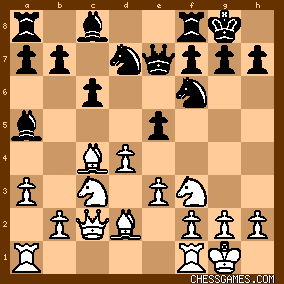
click for larger viewThus far identical to Botvinnik-Euwe played a few days earlier in this same tournament, a game Botvinnik won impressively. See my commentary on that earlier game for an analysis of the moves played thus far. Botvinnik here played 12. Rae1 and after 12...Bc7 13. Ne4 obtained no advantage from the opening. 13. Bc1 or 13. 13. Ng5 or 13. Bd3 might have been slightly better, but White would still have had no meaningful edge. For this reason, Euwe may have thought he was on safe ground in repeatedly his earlier play. But Reshevsky had apparently burned the midnight oil and prepared what he doubtless thought was an improvement: 12. d5
"!" -- (Golombek)(Kmoch)(Euwe)
"A typically forceful move that jolts Dr. Euwe out of his peaceful and prepared theoretical path into an intensely difficult jungle of awkward possibilities." (Golombek) "An important deviation from the game Botinnik-Euwe where White played 12. Rae1 permitting Black to equalize. Reshevsky's move is much stronger. It leads to a clear advantage for White. One can almost speak of it as a refutation. Euwe has to find some considerable improvement if he wishes to play this system again." (Kmoch). But is 12. d5 all that good. Hardly. In fact, with best play, as I will attempt to show, it leads to little more than equality for White. The crucial line which does indeed give White much the better game is the one later identified by Keres: 12. Ba2!: "It is apparent that Black's main strategical plan is the e5-e4 advance, as the exd4 exchange would open up the e-file and give White a clear advantage. This advance is however not possible at the moment due to the simple reply Nxe4, as Black's Bishop on a5 is unprotected. Therefore one could expect Black to want to move the a5-Bishop, most naturally to the e7 square. White had to thwart this, and it was possible with the positionally useful retreat 12. Ba2! Now 12...Bc7 is no longer possible due to the reply 13. Nb5 and secondly Black has to consider the threat of 13. Nd5...It seems [therefore] that White could have maintained an opening advantage with 13. Ba2!." (Keres) By contrast, after Reshevsky's actual 12. d5, the position was: 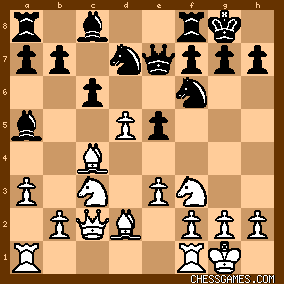
click for larger view"The continuation chosen by Reshevsky is...hardly sufficient to assure White of an edge." (Keres) True, but over the board, the text unleashes a plethora of options that I will discuss in my next post on this game. While Euwe COULD have threaded his way to safety, this is not so easy to see with the clock running. Perhaps the best assessment of Reshevsky's move was provided by Euwe himself after the game: "Confronting Black with a very difficult problem." (Euwe) As will be seen, only Euwe among all the commentators found the best line for Black in answer to 12. d5. This line involved the sacrifice of the exchange in a position it is much nicer to evaluate when one has endless time and computers ready at hand to double-check one's calculations. As a sporting rather than as a theoretical matter, and given Euwe's likely fragile state of mind after having dropped his first three games in the tournament, Reshevsky's move looks pretty good. It led Euwe into trouble which, with best follow-up play by Reshevsky, was probably sufficient for White to win (though the later course of the game was not that simple). |
|
| Feb-20-21 | | sudoplatov: 12. Ba2 Bc7
13. Nb5 Bb6
14. Bb4 seems stronger than Nb4.
It's all apparently opening theory. Perhaps 7...Bd6 is better than 7...Ba5. |
|
Feb-21-21
 | | KEG: Post II
12... c5?
"?"--(Keres)(Euwe)(Golombek)(Wade-Whiteley-Keene) The commentators are unanimous in their condemnation of 12...c5? The question is: which of the many move available to Euwe was best? Let's take stock. First, the dross can be discarded:
(A) 12...Nxd5? This just loses the exchange for inadequate compensation: e.g., 13. BxN [Much better than 13. NxN cxN 14. BxB dxB 15. Bb4 Nc5 16. Qxc4 as given by Golombek and Kmoch after which White wins a pawn (16...b6 17. BxN bxB 18. Rfc1) but Black has some counter-play) 13...BxN 14. BxB cxB 15. Bb4 Qe6 16. BxR NxB 17. Rfd1. B) 12...cxd5? loses a pawn after 13. Nxd5 NxN (if 13...Qd8 as suggested by Kmoch then 14. BxB [much better than Kmoch's 14. Rfd1] QxB 15. Ng5! Qd8 16. Nxf7! RxN 17. Nc7! and Black is toast) 14. BxB N7b6 (not 14...N5b6 15. Bb4) and now 15. BxN(d5) NxB 16. Qe4 Nf6 17. Qxe5 which is stronger than Golombek's 15. Bd3 since Black could then play 16...h6 rather than Golombek's much weaker 16...f5? which loses to 17. e4 fxe4 17. Bxe4 g6 and now 18. Rfe1 (stronger than Golombek's 18. Rad1 after which Black should try 18...Be6 rather than the suggested 18...Rd8?) 18...Be6 19. BxN(d5) NxB 20. Rxe5 and White should win with his extra pawn. Having disposed of the weaker moves for Black, let's consider the four good choices, all of which were probably sufficient to hold the game. In ascending order of merit, these are: C) 12...e4
D) 12...Nb6
E) 12...Bc7
F) 12...BxN
C) 12... e4

click for larger viewThis move, favored by Kmoch, is probably the trickiest of the options available to Black. White now has two possible lines (13. dxc6 gives the edge to Black after 13..exN 14. cxN Bxd7 [better than 14...fxg2 15. Rfd1 Qxd7 (not 15...Bxd7 16. Nd5) 16. Nd5 Bc7 with about even chances] 15. Rfd1 [15. gxf3 Qe5 is even worse] Qe5), both of which lead to an edge for White but not to anything approaching a win: (i) 13. Nxe4 BxB
14. NexB cxd5
After which White has a most a small advantage because of the isolated Black d-pawn after either 15. Be2 or 15. Bd3. (ii) 13. d6 Qxd6
14. Nxe4 NxN
15. BxB Ndf6
After which White has only a small edge because of his two Bishops. (D) 12... Nb6
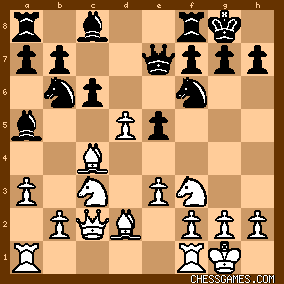
click for larger view13. Ba2 BxN
14. BxB Nbxd5
14...Nfxd5 is perhaps even better, but the text (given by both Golombek, Euwe, and Keres) is also OK. 15. Bxe5 Bg4
"...with an almost equal position." (Euwe); "...with a good position for Black despite Black's Bishop pair." (Keres) The above comments notwithstanding, I tend to agree with Golombek that White here after 16. Bd4 has a distinct (though hardly winning) edge because of his two Bishops. In my next post on this game, I will turn to the seemingly superior 12...Bc7 and to Euwe's analysis of 12...BxN which I believe is the best line and one that appears to have been missed by all of the other commentators. |
|
Feb-21-21
 | | KEG: in my first post, my quotation of Keres contained a typo. What Keres said was: "It seems [therefore] that White could have maintained an opening advantage with 12. Ba2!" [not "13. Ba2" as I incorrectly quoted Keres]. With regard to the line 12. Ba2 Bc7 13. Nb5 Bb6 <sudoplatov> is correct that 14. Bb4 is best. But I do not understand the reference to "Nb4" which is not possible at that point. |
|
Feb-21-21
 | | KEG: Post III
Returning to the position after 12. d5:

click for larger viewLet us now consider Black's two strongest responses: E) 12... Bc7
Both Golombek and <Gypsy> favor this continuation. It does seem to yield a playable position for Black, though hardly equality. Let's examine: 13. dxc6
This continuation, favored by Golombek, Euwe, and Keres, looks even stronger than 13. e4, which also leaves White with the better chances. 13. Nb5 as suggested by <Gypsy> just seems to lose a piece and the game after 13...cxN. 13... bxc6
This leaves:
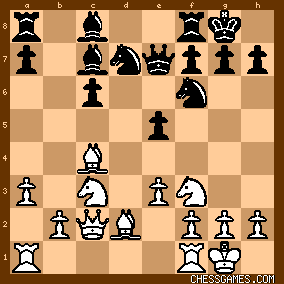
click for larger viewThe problem with this line for Black is, as acknowledged by Golombek, the isolated c-pawn. Euwe questions whether this weakness "will be of much consequence." Only Keres looks beyond 13...bxc6. He gives 14. Ne4 as best and evaluates: "...a sharp position where Black does not lack for counterplay. I agree that Black is basically OK after 14. Ne4, a likely line being 14...NxN 15. QxN Rb8 (no doubt the "counterplay" Keres had in mind) 16. Bc3 c5 17. Rfd1 Nf6 resulting in an unbalanced exciting position in which White is probably slightly for choice but in which both sides have chances. But White can surely do better than Keres' 14. Ne4. The strongest line for White appears to be 14. Ng5. Black can probably hang on, but I would not enjoy defending the Black position after 14. Ng5 against a strong attacking player. xxxxxxxxxxxxxxxxxxxxxxxxxxxxxx
Let's now consider what is probably Black's strongest choice, an assessment shared by Euwe and <ughaibu>: F) 12... BxN
Play would then continue:
13. BxB

click for larger view13... cxd5
This move, favored by Golombek, Kmoch, Euwe, and Keres, is surely best and leaves Black well situated. It is much stronger than 13...e4?! as given by <ughaibu> after which White has much the better position after 14. Nd2 (as given by <ughaibu>) but even more so after 14. dxc6 or maybe 14. Nd4 (e.g., 14. dxc6 exN 15. Bb4 after which Black has nothing better than 15...Qe5 16. cxN Bxd7 17. BxR fxg2 18. Rfd1 RxB 19. Be2 where Black's compensation for the lost exchange seems questionable at best. 14. Bb4
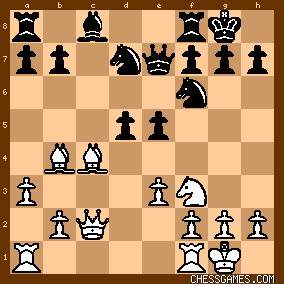
click for larger viewHere, all of the commentators other than Euwe play 14...Nc5 and end up with a clearly inferior position (Keres' claim that White only has a "somewhat freer position" does not reflect the reality on the board) after 15. Bxd5 NxB 16, BxN Qc7 17. Rfc1 (better than 17. Rac1 given by Golombek, Kmoch, and Keres), Euwe may have lost this game over the board to Reshevsky, but in my book he won the post-mortem hands down with: 14... Qe6!
This wonderful resource appears to have been overlooked by everyone other than Euwe. Play would now continue: 15. BxR dxB
16. Bb4 a5!
17. Bc3 b5
"...and Black has reasonable compenstion for the exchange." (Euwe) 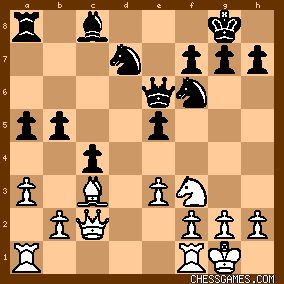
click for larger viewBRAVO Euwe. A reminder that--despite his failure at the 1948 World Championship Tournament--Euwe was a fine player (he did win a match against the mature Alekhine!) and a superb analyst. This line does appear to represent best play for both sides after 12. d5 and demonstrates that Reshevsky's innovation, though a good sporting choice in this contest, has been rightly relegated to the dustbin. The refutation, if any, of Euwe's opening lies in 12. Ba2 (Keres's idea) and not in 12. d5. |
|
Feb-21-21
 | | KEG: Post IV
Having considered all of the alternatives, let us return to Euwe's actual (and awful) 12th move: 12... c5?
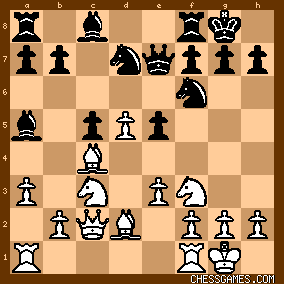
click for larger view13. d6!
"!"--(Golombek)(Kmoch)(WWK)(Euwe)(Keres)

click for larger view"Very strong...Black threatened to consolidate his position by 13...Ne8 and 14...Nd6." (Golombek) "This pawn, which Black cannot capture due to 14. Nb5 Qb6 [or 14...Qa6 15. Nc7--KEG] 15. b4 winning a piece, now considerably hinders Black's development, and assures White has a positional advantage sufficient for a win." The above diagram tells the story. Black is busted. It is a testament to Euwe's fighting qualities that--even after starting this tournament 0-3 and finding himself in this horrific bind--nonetheless managed to make a fight of the game and nearly saved himself. The following play reveals all the pitfalls Euwe faced on nearly every move. Under the circumstances, I'm far from sure I would have been able to muster the fortitude to put up any real opposition. 13... Qd8
13...Qe8 14. Rfd1 Bd8 15. Ng5 Nb6 was perhaps slightly better, but would hardly have been very pleasant for Black. After 13...Qd8, even a quick glance at the board reveals the deadly bind in which Euwe found himself: 
click for larger view14. Rad1
14. Rfd1 was even stronger for White. The text, however, was more than adequate to keep Euwe hopelessly constricted. 14... Rb8
"Preparing the ...b7-b5 advance in order to...be able to develop the Bishop to b7. The d6-pawn already has a disruptive effect on Black's development." (Keres). Euwe was obviously straining to find means of counterplay. 14...Nb6 and 14...h6 were alternative means of attempting to construct a defense. But in this situation, I have no great suggestions for Black. As a practical matter, Euwe's move might offer the best practical chance. To add to his other troubles, Euwe was beginning to get into time troube,his clock (according to Kmoch) now reading: 0:50. 15. Nd5!
"!"--(Keres)

click for larger viewReshevesky was also starting to get into time trouble, his clock (according to Kmoch) now reading: 1:08. |
|
Feb-21-21
 | | KEG: Post V
15... NxN
An unpleasant necessity. The alternatives, however, were even worse. As Golombek and Euwe pointed out, 15...BxB would get crushed by 16. Ne7+. 15...b5? would be even worse. It would, as Kmoch pointed out, lose the exchange to 16. BxB QxB 17. Ne7+ [17. b4 would be even stronger: 17...Qd8 18. Ne7+ Kh8 19. Nc6 Qe6 20. NxR NxN 21. Bd5--KEG] Kh8 18. Nc6. But after 15...b5? White's truly crushing line is the one pointed out by Keres: 16. Ne7+ Kh8 17. Nc6 (even better than Keres' 17. BxB QxB 18. Nc6). So Euwe's 15...NxN was best play. The problem, to quote Keres, was that his position "was already lost after the mistake he made on the 12th move." After Euwe's 15...NxN, the position was:

click for larger view16. BxB
18. BxN also wins. Golombek's claim that after 16. BxN BxB 17. RxB b6 "Black is out of trouble" is plainly ludicrous. After 16. BxB, the position was:
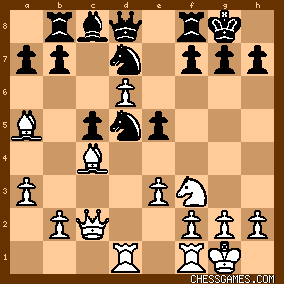
click for larger view16... QxB
16...b6 is no real improvement. And the wild 16...Nxe3?, as noted by Golombek, gets annihilated by 17. fxN QxB (17...b6 saves Black from immediately getting mated, but is obviously hopeless) 18. Ng5 and now Black gets mated after 18...Nf6 19. RxN!. 18...e4 or 18...g6 would only delay mate slightly. 17. RxN
17. BxN would also have been sufficient to win. After Reshevsky's actual 17. RxN the position was: 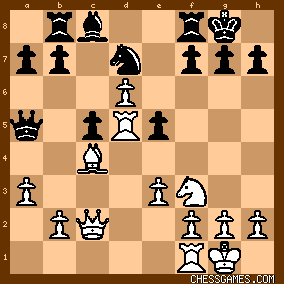
click for larger view |
|
Feb-22-21
 | | KEG: Post VI
17... e4?!
"The only way of holding the e-Pawn, temporarily at any rate." (Golombek) "The best Black can do." (Kmoch)
"Black's only hope of counterplay." (Euwe)
The text was hardly sound, but the alternatives were not pleasant. 17...Re8, as Kmoch correctly commented, "loses quickly": 18. Ng5 g6 (if instead 18...Nf6 19. Rxc5! [19...QxR would run into 20. Bxf7+ dropping the Queen]) 19. Rdd1 with 20. Bxf7+ to follow (even better than Kmoch's winning 19. Nxf7 b5 (19...Kg7 was perhaps slightly better but hardly any real solution) 20. Nxe5 bxB 21. Nxg6! 17...b5 is somewhat better, but still manifestly insufficient to save the game: 18. Bd3 (as per Golombek, Euwe, and Keres and much stronger than Kmoch's 18. Ba2 [which also probably wins] g6 (18...e4 is arguably stronger but ultimately useless after 19. Bxe4, while Keres' 18...Bb7 gets crushed after 19. Nxe5) 19. Nxe5. Best theoretically was probably 17...Qd8, but as Golobek explained even this looks hopeless in light of 18. Nxe5 NxN 18. RxN Qxd6 19. Rxc5 after which--the Rook obviously being immune from capture--White is a healthy pawn ahead with the only real attacking chances. All in all, and despite what your friendly computer will tell you, the text (17...ex4?!) was probably the best practical chance for Euwe. It left the position as: 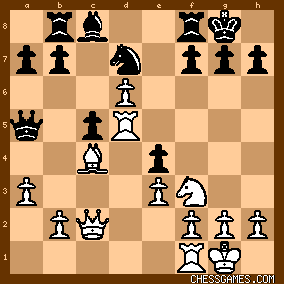
click for larger view18. Ng5
Not best, but Reshevsky's position was still so good he could afford this sound but definitely second-best move. Indeed, and as Kmoch aptly mentioned, even if Reshevsky had fallen into Euwe's "trap" with 18. Qxe4 Nf6 White would still win with 19. Qc2 [19. Qe7 would be better than Kmoch's move] NxR 20. BxN after which White's passed d-pawn far outweighs the lost exchange. Better in this line would have been 18...b5 , but White would still win with 19. Bd3 g6 20. Qe7. Best for White here, however, would be Golombek's 18. Ne5! If then 18...NxN as per Golombek (18...g6; 18...b5; and 18...Kh8 are all arguably better, but also insufficient to save the game) 19. RxN Qd8 (19...Qb6 or 19...b5 also lose) 20. Rd1 b6 (this effort by Golombek is hopeless, but the "better" 20...b5 or 20...Bg4 would also fail) 21. Qxe4 (21. d7 is even stronger than Golombek's move; though at this stage it hardly matters) Qf6 22. d7 Bb7 23. Bd5 (even more crushing is 23. Qf5) BxB 24. RdxB (24. RexB also wins) Rbf8 (24...Qc6 also loses) 25. Re8 g6 26. g4 (or, even better than Golombek's move, 26. h4). After Reshevsky's 18. Ng5, the position was:
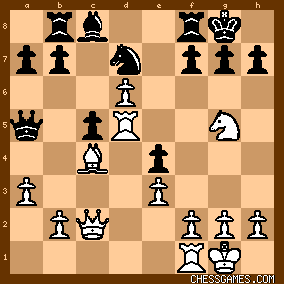
click for larger view18... b5
"The difficulty of the Black position is shown by the fact that he cannot make the natural move 18...Nf6 because of 19. Rxc5 Qb6 20. Bxf7+." (Golombek) Meanwhile, both players, according to Kmoch, were getting into time trouble: Reshevsky--1:23
Euwe-- 1:13
19. Ba2
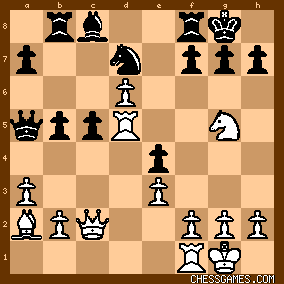
click for larger view19... Qb6
"The text-move prepares the c5-c4 advance." (Keres) As Keres pointed out, 19...Bb7 would lose to 20. Rf5 Nf6 (a better try than Golombek's 20...c4 21. Bxc4, exploiting the pin on the Black b-pawn) 21. Rxc5 (or, even better, 21. Qxc5). After 19...Bb7, White can also win in spectacular fashion to 20. Rxc5! NxR 21. QxN h6 22. Nxf7! RxN 23. d7 and White, though a full Rook down, still wins; e.g., 23...Rbf8 (23...Qd8 24. Rd1 also wins for White) 24. Qe7 (what a remarkable position!) Qd8 25. BxR+ Kh8 26. Qe8! Bc6 27. Rd1 (a lovely "quiet"move) Bxd7 28. QxQ RxQ 29. Be6 and wins. After 19...Qb6, the position was:

click for larger view |
|
Feb-23-21
 | | KEG: Post VI
20. Nxe4?
"Winning the Pawn but allowing Black distinct counter-chances." (Golombek) "It is true that with this move White wins a pawn, but it gives Black time to consolidate his position and organize and efficient resistance." (Keres) With regard to the merits of 20. Nxe4, Keres and Golombek said it all. After the text, it is far from clear that Reshevsky still had a theoretical win. Yet again, Reshevsky's habit of getting into time trouble led him to misplay what should have been a winning position and could easily have allowed Euwe to save the game. The winning move for White here, as was noted by all of the commentators, was. 20. Rf5! This would have left the position as follows: 
click for larger viewIn response to 20. Rf5, Euwe would have had two plausible replies: (A) 20...Nf6 and (B) 20...c4 (Black's best chance). Let's look first at (A) 20...Nf6:
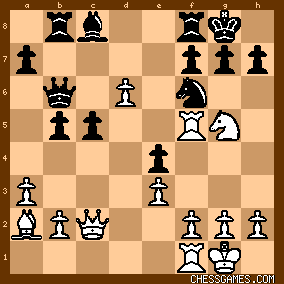
click for larger viewWhite now wins in a walk:
21. Rxc5 Qxd6
This is the response offered by Keres and Golombek. It gets crushed by: 22. Nxf7!
But the variation gets more interesting (though White still wins) with: 21...Bd7 22. f3 Qxd6 23. Nxf7 RxN 24. BxR+ KxB 25. fxe4 Re8 26. Rd1 Qb8 27. Rc7 Kg8 28. RcxB NxR 29. RxN and White should win easily with his extra pawns. B) 20... c4 is more interesting:
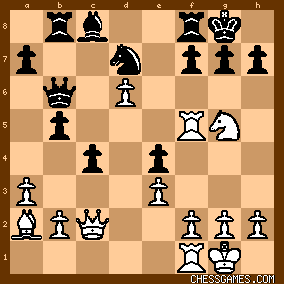
click for larger view21. Qxe4 Qxb6
Kmoch's suggested 21...g6 gets annihilated by 22. Rxf7 (much stronger than Kmoch's 22. Qh4) Qxd6 23. Rxh7 Rf5 24. Qh4. On the other hand, 21...B
b7 (a move not considered by any of the commentators) might give White some trouble, but the win would still be there after 22. Qf4. 22. Rxb5 Nf6
23. Qxc4 Ng4
None of the commentators considered this move, which is probably Black's best. The two moves they did consider are even more unavailing: (i) 23...RxR 24. QxR Ba6 (the only move given in the commentaries, 24...Bd7 also loses after 25 Qc4 Be8 26. Qd4 and White wins with his two extra pawns) 25. Nxf7 RxN 26. BxR+ KxB 27. Qb3+ and White with Rook and three pawns for Black's Bishop and Knight should win without difficulty; (ii) 23... Ba6
24. Qxf7+!
24. Nxf7 BxR is--as Keres pointed out--less convincing though still a likely win. 24... RxQ
25. NxR Qf8
This move (given by Golombek) is hopeless. Also hopeless is 25...Qc7 (the move championed by Keres and Kmoch) which loses to. 26. RxR QxR 27. Rd1. The "best" (though inadequate) move is 25...Qxh2+! 26. KxQ BxR 27. Rc1 and White should be able to win the ending with his extra two pawns. 26. Nd8+ Kh8
27. RxR
And White wins pretty much as he pleases.
By contrast to the above variations after 20. Rf5, the position after Reshevsky's actual 20. Nxe4: 
click for larger viewAll of a sudden, the outcome was in doubt:
20... Bb7
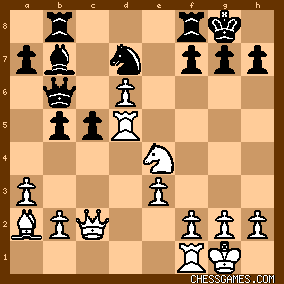
click for larger viewReshevsky: 1:35
Euwe: 1:20 |
|
Feb-23-21
 | | KEG: Pardon the typo. My last post was Post VII |
|
Feb-24-21
 | | KEG: Post VIII
21. Rd2
"After the missed opportunity on the 20th move, White has to refrain from an attack against the King, and start the laborious process of realizing his extra pawn." (Keres) As Golombek pointed out, had White played 21. Ng5 (about a good as Reshevsky's actual 21. Rd2), 21...Nf6 would get crushed by 22. Rf5, and Black should therefore play 21...g6. Golombek's analysis from that point is feeble. White should then simply play 22. Rd2 and not Golombek's awful 22. Rf5?; and then after 22...c4 Golombek's 23. Rd1 is weak ((White would have to play for equality with 23. b3 or 23. Rf4) since Golombek's proposed 23. Rd1 allows Black to get the better game with the intermediate move 23...Qc6! (rather than Golombek's 23...Nc5 after which the edge switched back to White with 24. b4 with 25. a4 to follow after 24...Nd7. 21. Nxc5 would also not be significantly inferior to Reshevsky's actual 21. Rd2 since, contrary to Golombek's completely erroneous evaluation, Black would have nothing better than 21...BxR 22. NxN Qxd6 23. Bb1 g6 24. NxR(b8) QxN (leaving Black a pawn down in a tricky ending in which he might have decent chances of saving the game). By contrast, Golombek's suggested 21...Qc6? leads to a clear loss even on Golombek's line: 22. Bb1 (even stronger is 22. Rfd1) Nf6 (22...g6 is slighty better, though hardly a panacea) 23. Rg5 (both 23. Rfd1 and 23. e4 would be better) Qxd6 (23...Rfd8 or 23...h6 would be better, but still hopeless) after which Golombek's claim that: "though he is a pawn down, Black should have excellent drawing chances owing to the workmanlike position of his pieces" is simply wrong: e.g., 24. Rd1 Qc6 (Black has nothing better) 25. Nd7 QxQ 26. NxN+ (perhaps Golombek missed this intermediate move resource) Kh8 27. BxQ gxN 28. Rxb5 when White is up two pawns and has a sound pawn structure while Black's pawns are a mess. What all the commentators appear to have missed is that the best move for White was the simple retreat 21. Rdd1 after which he would have good chances to prevail based on his extra pawn. In any case, after Reshevsky's 21. Rd2, the position was: 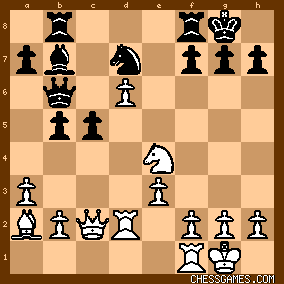
click for larger view21... c4
22. Bb1
"Threatening 23. Nc5 Nf6 24. Nd7." (Golombek).
22. b3 and 22. Nc3 were both arguably slightly superior. 22... g6
Reshevsky: 1:47
Euwe: 1:32
23. Qc3

click for larger view23... Rfe8
Keres proposed two alternatives to this move, neither of which strike me as improvements. Keres' analysis was based on his concern that the coming exchange of Knights (after 24. Nf6+) "...White's passed pawn becomes very dangerous." He therefore suggested 23...BxN 24. BxB Rfe8 "...and an eventual attack by a5." But, on Keres' line, while Black may well be able to rid himself of the intruding White d-pawn, but the remedy looks worse than the disease after 25. Bf3 Nc5 26. Rfd1 Rbd8 27. h4 Nd3 28. b3 Rxd6 29. a4 a6 30. bxc4 bxc4 31. Qxc4 Nb2 32. RxR NxQ 33. RxQ NxR 34. Rd6 and White eventually nets a two-pawn advantage in an easily won ending. Alternatively, Keres suggests that if Black is prepared to live with the trade of Knights, he should play 23...Qc6 24. f3 Rfe8. 24...Qb6 looks better than Keres' move here, but leaves Black in worse shape than in the actual game. And if Black does play Keres' suggested 24...Rfe8, then White seems to have a commanding bind--not to mention an extra pawn--after 25. Qd4. After Reshevsky's actual 23...Rfe8, the position was: 
click for larger viewEuwe: 1:43
Reshevsky now had to decide whether to swap Knights with 24. Nf6+. |
|
Feb-24-21
 | | KEG: Post IX
24. Nf6+
Opinion is sharply divided on the merits of this move. "Removing a vital piece from the Black defense--the blockading Knight." (Gomombek) Keres, who warned of the dangers to Black posed by 24. Nf6+, also liked the text. By contrast, Euwe, who claimed that the trade of Knights would "significantly...help the defense," suggested 24. Ng3. But that can't be right, since Black would then be in good shape with 24...Re6. Kmoch suggested the interesting 24. Qd4. This does work out brilliantly if Black responds 24...Qc6, since then White just plays 25. f3. The only response Kmoch considers to that is 25...Re6 which simply drops a pawn after 26. Qxa7 (Kmoch, mysteriously, gives the timid 26. Nf2?). But Black seems to have a decent chance to survive in response to 24. Qd4 with the simple 24...QxQ. All in all, none of the proposed alternatives seem to be any real improvement upon Reshevsky's 24. NxN+ 24... NxN
25. QxN Qc6

click for larger view26. e4
"?"--(Keres)(Wade-Whiteley-Keene)
"An anti-positional advance completely shutting the b1 Bishop out of the game and also weakening the dark squares in the center. This gives Black the chances to organize effective counterplay... With the text-move, White perhaps hoped to proceed with f2-f4-f5 or a later e4-e5, but Black's following counterplay at least initially thwarts these hopes." (Keres) Much better than the text would have been 26. Qg5 as suggested by Keres and Euwe. As in his above comments, Keres said it all: "It was necessary to [take up a defensive position temporarily] with the move 26. Qg5, and at the same time open up the road for the d6-d7 advance." 26... Re6
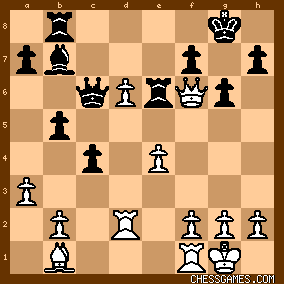
click for larger view27. Qf4!
Best. The alternative 27. Qd4 would be counter-productive, as explained by Golombek: "Though White is still a pawn up after 27. Qd4 Rd8 28. Qxa7 Rexd6 29. RxR RxR 30. Qe3 Qd7 Black's command of the d-file is good compensation." 27... Rd8
28. Rfd1
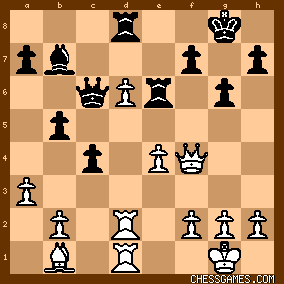
click for larger view28... a5
Some of the commentators extolled this advance:
"With the strong menace of utilizing his Q side majority to force a free passed Pawn on that wing." (Golombek) "Black's only chance: his pawn majority on the queenside." (Euwe) But Keres looked more deeply into the position, first noting that: "The attacking attempt on the queen-side initiated with the text-move; which Black could always have started at a later point, is not very dangerous for White." Keres then went on to identify an improvement on 28...a5: "In order to avoid the following complications [i.e., Reshevsky's answering 29. h4!--KEG], 28...Rd7 came into consideration, with the intention of playing ...Qc5." All well put by Keres. But the best analysis of the position was given by user <wwall> on this site, who proposed 28...f5! as best for Black. Though <wwall> gave on continuation, the following line appears to support his idea: 29. f3 fxe4 30. Bxe4 Qc5+ 31. Kh1 BxB 32. fxB Qe5 33. QxQ RxQ leaving a double Rook ending with White a pawn ahead but with White's passed d and e pawns blockaded and with Black still enjoying a Queen-side majority. White would, at best, have an extremely onerous task in trying to prevail in this ending. By contrast, after Euwe's 28...a5, Reshevsky had a stronger--even if not theoretically winning--advantage: 
click for larger view |
|
Feb-25-21
 | | KEG: Post X
29. h5!
White's best winning chance.
"At once providing an escape for the White King and preparing to storm the somewhat weakened Kingside of his opponent." (Golombek) 29... h5
"...an unnecessary weakening of Black's King-side." (Keres) As Keres went on to point out, 29...Rd7 (and also 29...a4--KEG) was much better than the text. But he was wrong in claiming that after 30. h5 Black would be safe with 30...gxh5. In fact, this ugly move would lose to 31. Rd5 (e.g., 31...f6 32. Qf5 Rexd6 33. QxR! RxQ 34. RxR Bc8 35. Re7 Kf8 36. Rxh7 Ke8 37. Rh8+ Ke7 38. e5! fxe5 39. Rh7+ Ke8 40. Rxh5 Kf7 41. Rxe5. Rather, after 30. h5 Black can probably save himself with 30...Qc5. Though <wwall> correctly noted the virtues of 28...f5, his suggestion of 29...f5 here does not work (e.g., 30. Qg5 Rdxd6 31. RxR RxR 32. RxR QxR 33. exf5 and now neither 33...Kf7 34. fxg6+ nor 33...Qd1+ 34. Kh2 Bc6 (if 34...QxB? Black gets mated after 35. Qd8+ Kf7 36. Qd7+ Kf8 37. f6) 35. fxg5 QxB 36. Qd8+ Kg7 37. Qc7+ Kxg6 38. QxB+ Kf7 Qxb5 will save Black. After Euwe's actual 29...h5, the position was:

click for larger view30. d7?
"?"--(Golombek)(Euwe)(Wade-Whiteley-Keene)(Keres) This precipitous advance has been universally and properly condemned. It forfeits all of White's winning chances. "Reshevsky, now getting very short of time as usual, deprives his d-pawn of its third support and so dooms it." (Golombek) "This premature advance is no doubt stimulated by the fear that Black will create a passed Pawn on the Queen-side which may be more dangerous than White's Queen Pawn. The threat is 31. Rd6 [which as we will see is easily parried--KEG]" (Kmoch) "Too hasty." (Euwe)
"A mistake whereby White loses his strong passed pawn in exchange for only unclear attacking chances. Even though White did not have an easy task to realize his material advantage, there was no need to create such risky complications." (Keres) Since, as will be seen, Reshevsky's 30. d7? should have allowed Euwe to escape with a draw, the question to be answered is: How should Reshevsky have tried to exploit his material edge. Two alternative moves have been suggested, and I will propose a third. (A) 30. Qg3
This move was suggested by Golombek, Kmoch, and Euwe. This idea would work splendidly against the reply of 30...b4 (as given by Golombek and Euwe) since White then wins with 31. axb4 axb4 32. Rd4 ["!"--Euwe] (this move should forfeit the win which was there in this line with 32. Rd5--KEG] c3 [This is awful, Black can here probably save himself with 32...Rd7] 33. bxc3 bxc3 34. Bc2. But after 30. Qg3, Black can survive with 30...Qc5. In sum, with best play, 30. Qg3 is probably inadequate. (B) 30. Rd4
This move, championed by Keres and by Wade--Whiteley-Keene, probably wins. Keres gives no follow-up to 30. Rd4, except to say that White should continue with Qd2, f4, and e5. But he appeared to overlook that after 30. Rd4 Rd7 31. Qd2 Qb6 makes 32. f4 impossible (it obviously loses to 32...Rxe4). But White still has excellent winning chances even after 31...Qb6 with 32. Bc2 Kh7 33. Qf4 Qc6 34. Rd5 c3 (the best chance) 35. b3 b4 36. axb4 axb4 37. e5. The win, however, is less than certain. Is there anything better? I think so:
(C) 30. Rd5
This move is not discussed by any of the commentators, but is the choice of both Fritz and Stockfish. The win is still tough for White, but it seems to be there after 30...Qd7 (best) 31. R5d4 Qc6 32. Bc2 Kg7 33. Qd2 Qb6 34. Qc3 b4 35. axb4 axb4 36. Qxc3 Rexd6 37. RxR RxR 38. RxR QxR 39. Bb3 It is of course, much easier to find these sorts of lines with no clock running and powerful computers near at hand. With time running out on his clock, it is impossible to imagine that Reshevsky could have explored all of his options. After Reshevsky's actual 30. d7, the position was: 
click for larger view30... Re7
"A counter-combination." (Kmoch)
"This move enables Black to capture the enemy passed pawn and equalizes the position." (Euwe) The position now, after 30...Re7, was:
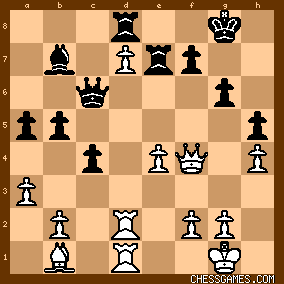
click for larger view |
|
Feb-26-21
 | | KEG: Post XI
31. g4
"...shows great courage on the part of one with only five minutes left on the clock." (Golombek) "...the only way to stir up some complications in exchange for the d-pawn." (Keres) "Apparently, when making his previous move, White did not notice that after 31. Rd6 Black can simply play 31...Rexd7." (Keres) Continuing Keres' line, after 31...Rxd7: 32. RxR [Not 32. RxQ? RxR+ 33. Kh2 BxR after which White would have to struggle to save the game] RxR+ 33. Kh2 BxR and Black suddenly has the better chances. After 31. g4, the position was:

click for larger viewReshevsky: 2:25
31... Rexd7
As Golombek and Kmoch pointed out, 31...hxg4 32. Qxg4 Black's position would again be perilous. If then 32...f5? as suggested by Golombek (32...Qe6 is the best chance to try to hold the game from here) 33. Qg5 looks like a winner for White. And if then 33...Kf7?? (as given by Golombek; 33...Rdxd7 is the only chance) 34. Rd6? is a killer. 32. gxh5
"!"--(Kmoch)
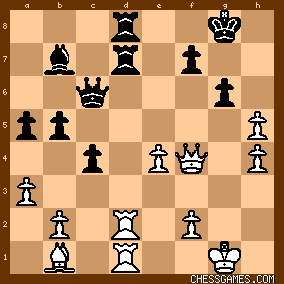
click for larger view32... RxR
"?"--(Golombek)
This "?" by Golombek is preposterous. It is true that Black would also be OK with 32...gxh5 as pointed out by Golombek and Euwe, whether White now plays 33. RxR RxR 34. RxR (or 34. Qg5+ Kf8) QxR (Golombek's line) or 33. Qg5+ Kf8 (Euwe's line). But, as will be seen, the text (i.e., Euwe's 32...RxR is more than adequate to draw with proper play). 33. RxR RxR
34. QxR
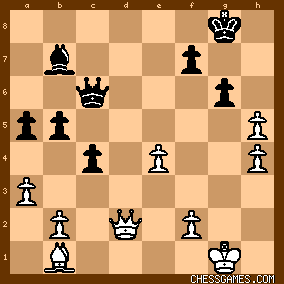
click for larger viewEuwe had been battling gamely in a difficult and often losing position replete with incredible complications since his poor 12th move. Now, finally, he had reached a decent position that that was much clearer and easier to calculate that he should have been able to draw. But beginning here, as so often happened to Euwe in this tournament, he faltered at the end, rendering all his valiant efforts over the last more than 20 moves a nullity: 34... gxh5?
"?"--(Golombek)(Kmoch)(Keres)(Wade--Whiteley--Keene). "??"--(<wwall>) "With this capture, Black loses important time, since he is unable to protect the pawn on h5 in any event." (Keres) As all of the commentators have pointed out, Euwe could almost certainly have saved the game here with 34...Qf6! To quote Keres again, 34...Qf6: "...would attack the pawns on b2 and h4 and tie the White Queen to the defense of the b2-point. It is unlikely that White would be able to win the endgame, because the active position of the Black pieces fully compensates for the pawn minus." After 34...Qf6 play might continue [following Golombek] 35. hxg6 (if 35. Qxa5 Black--as noted by <wwall>--just plays 35...Qxb2) fxg6 36. Qc3 (if 36. Qg5 Black draws easily with 36...Qxb2, as pointed out by Euwe) Qxh4 37. Qxa5 (or 37. Qe5 Qg4+--KEG) Bxe4 (or 37...Qg5+ or 37...Qg4+) after which, to quote Golombek, "though White can eventually win the b-pawn, his own King is too exposed[to hope to be able to win]." After Euwe's unfortunate 34...gxh5, he may or may not have been definitively lost (as Kmoch claims), but he was clearly in deep trouble: 
click for larger viewReshevsky, in serious time trouble, could--as Golombek showed--have blown his winning chances with 35. Qxa5? Qg6+ (or 35...Qd7--KEG) 36. Kb1 Bxe4 ("which leads to a clear draw"--Golombek) But Reshevsky had a knack for finding first-rate moves when in desperate peril on the clock and here played: 35. Qg5+!

click for larger view |
|
Feb-27-21
 | | KEG: Post XII
35... Qg6?
"?"--(Golombek)(Euwe)
"??"--(Keres)
Despite his mistake on his previous move, Euwe still had at least practical drawing chances (it is not quite clear to me whether the game was lost for Black prior to Euwe's move 35 blunder). One thing is for sure, after 35...Qg6?, the game was lost for Black. "This leads to a lost Bishop and pawn ending." (Golombek). "The decisive error." (Euwe).
"Exchanging Queens is equivalent to resigning, since the Black King remains tied to the defense of the King-side pawns, while its White contingent can wander unhindered into the Queen-side via f2-e3-d4-c5 and then win all Black's pawns." (Keres) As all the commentators agree, Black's only chance of fighting on lay in 35...Kf8. If then, and after 36. Qxh5, Black's best hope lay in 36...Qd7 (see Euwe and <wwall>) and then 37. Qh8+ Ke7 (<wwall>) or 37. Bc2 b4 or 37. Qc5+ Kg7. The resulting endgame would be a tough fight for both sides, and neither my analysis nor searches by Fritz and Stockfish yield a definitive answer as to whether White can win. 36...Qd6 37. Qxb5 Qd1+ 38. Kh2 Qd6+ 39. Kg2 looks a bit more difficult for Black than the lines after 36...Qd7, but once again a definitive conclusion about the theoretical result is unclear. By contrast (after 35...Kf8 36. Qxh5) 36...c3? 37. Qh8+ and 36...b4? 37. Qxa5 are hopeless for Black as pointed out by Kmoch. After the text, Reshevsky was back in the driver's seat and made short work of the suddenly hopeless Black position: 36. QxQ+! fxQ

click for larger viewMaterial was equal, but the win for White is not very difficult. Perhaps worst of all for Euwe, White was no longer faced with tricky or lengthy calculations, so Reshevsky's desperate time trouble was no longer an issue. 37. f4
"!"--(Golombek)

click for larger view"The White King now establishes itself on d4, after which Black's Q-side falls." (Golombek) "Threatening to penetrate Black's position with the King (via d4), and there is nothing to do against it..." (Kmoch) The most thoughtful comment here is from Keres:
"In this way Black is deprived of the counter-chance g6-g5, and there is no longer any defense against the maneuver Kg1-f2-e3-d4; the endgame is hopeless." Faced with doom, Euwe tried for miracles:
37... b4
"Black, who is powerless in the face of White's King march to d4, tries to solve his problem quickly with his Queen-side pawns." (Euwe) This plan was hopeless, but so was staying pat with 37...Kg7 or 37...Bc8 and watching Reshevsky's King march to victory. 38. axb4 axb4
39. Kf2
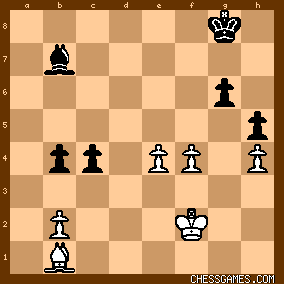
click for larger view39... c3?!
Keres claimed that the most "stubborn" defense lay in 39...Bc8 40. Ke3 Bg4 (40...Kg7 or 40...Be6 may allow Black to extend the game a few moves beyond Keres' line, but to no avail) 41. Kd4 c3 42. bxc3 bxc3 43. Kxc3. This, however, is entirely hopeless. The best practical chance was probably the text, since it forced Reshevsky to ponder the best 40th move before the time control was reached. After 39...c3?!, the position was:

click for larger view |
|
Feb-27-21
 | | KEG: Post XIII
40. b3
"!"--(Kmoch)
As Golombek noted, the text is even stronger than 40. bxc3 bxc3 41. Ke3, though that line eventually wins as well. After the text, by which Reshevsky made it to the move-40 time control, the game was over: 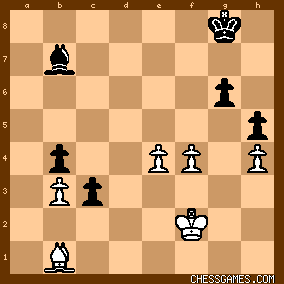
click for larger view40... Kg7
There is nothing better.
41. Ke3

click for larger viewHere the game was adjourned. Euwe sealed 41...Bc8, but later resigned without resuming play. As is obvious, Reshevsky here needed only to play Kd4-c5 and then begin gobbling up Black's Q-side pawns. |
|
Jul-05-21
 | | plang: It seems entirely in character for Reshevsky to play 20 Nxe4?! winning material and attempting to take advantage of his powerful pawn on d6 rather than playing for a kingside attack even though, in this instance, it was not the strongest option. Having said that 30 d7? was a surprising error no doubt influenced by time trouble. Fortunately for him Euwe played very poorly at the end in his own time trouble. |
|
 |
|
< Earlier Kibitzing · PAGE 2 OF 2 ·
Later Kibitzing> |
|
|
|





